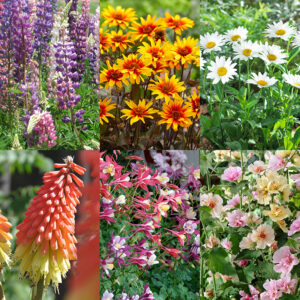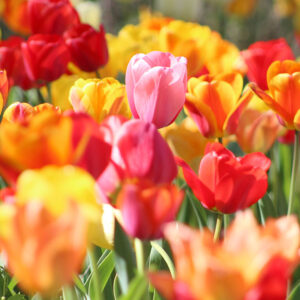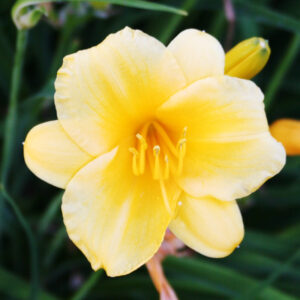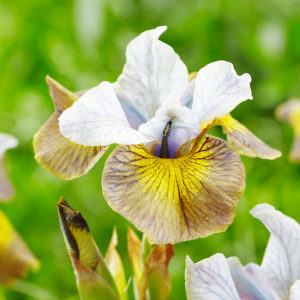The middle of summer is often the most relaxing time in the garden. Most new plantings are completed. It is the best time to sit back and enjoy the fruits of your labor. Maintenance and watering are the regular daily activities of the mid-summer garden, as gardening never really stops. However, plants can still be added in mid-summer and things can be moved around. Therefore, planting, watering, and maintenance questions often come up mid-summer—we have some answers to a couple commonly asked summer garden questions!
Frequently Asked Summer Garden Questions
Can I plant summer blooming bulbs in summer? Will they bloom this year?
The folks at Holland Bulb Farms are often asked is it too late to plant? The ideal time for planting summer-blooming bulbs is mid to late spring. However, summer planting will result in growth and blooms.
Planting summer blooming bulbs in mid-summer will produce blooms the same season they are planted. The main difference is that the flowers will appear later in summer going into early fall. This is not a bad thing, and a great way to extend the bloom season.
Another bonus to late-season planting is the soil and air temperatures are warmer. Since summer blooming bulbs prefer warmer soil and air temperatures, they will sprout much faster than they would in spring.
Late season planting is a budget-friendly way to add more bulbs to your garden next year if storing the bulbs is in your plans. Summer bulbs available in mid-summer are sold at clearance prices. Therefore, late-season planting combined with storing for next year will result in more bulbs for fewer dollars in the long run. A little extra effort goes into storing bulbs for winter but is worth the effort to have an increased inventory of flowers in your garden.
Can I transplant tulips and other fall-planted bulbs in summer?
Tulips are other spring-blooming bulbs are in dormancy by mid-summer. Therefore, transplanting them mid-summer will not utilize any excess energy. Spring-blooming bulbs prefer to be on the dry side in summer. If they are in an area that receives excess water (near annuals or new transplants) it may be best to wait until fall to re-plant them.
If you want to wait until fall to re-plant you can certainly store the bulbs until then. Spring-blooming bulbs should be stored in a location that is a moderate temperature (60’s is ideal) dark and dry so that they can ripen. They do not need to be stored in the soil. They can be stored in a crate, tray, or paper bag with ventilation. Check the bulbs on a weekly basis when in storage to make sure no rotting or excessive drying is occurring. If you notice any mold or damaged bulbs in storage they should be removed and thrown away.
What do I do when the flowers are done blooming?
Maintaining the garden is one of the top priorities of the summer garden. Removing faded and spent flowers is an important garden maintenance task. Some flowers will even re-bloom if the spent flowers are removed after they are done blooming. Perennial salvia is a great example of a perennial flower that will re-bloom later in the season if the spent flowers are removed. Perennials like daylilies will have a more neat and tidy appearance when the spent flowers, including the flower stem, are cut back to ground level.
Some flowers don’t need to have their blooms removed once they are finished. Coneflower and black-eyed Susans spent flowers are often visited by birds in winter, therefore leaving their flowers on once they are done has a benefit.
In general, it is ok to remove the flowers including the stems of perennials in the garden. This helps the plant’s energy reserves for more blooms later in the season or the next season.
Can I divide perennials and bulbs in summer?
Perennials like daylilies, hosta, and Siberian iris need to be divided every few years. The ideal time to divide perennials and bulbs is after they are finished blooming for the season. Therefore, if you have Siberian iris, hosta, daylilies, oriental lilies, Asiatic lilies, and other perennials that look like they are overgrown and crowded they can be divided in summer. Since dividing them will shock their root system it is important to provide plenty of water upon transplanting, and also for several weeks after transplanting.
My lilies are done blooming and have now disappeared. Are they dead?
No, they are certainly alive! Like all flower bulbs, lilies go dormant after they are done flowering each year. Therefore, when planting lilies it is important to plant other bulbs and perennials around them to fill the space they leave in late summer once they finish blooming.
Have garden questions?
I am happy to answer garden questions for summer, fall, spring, and even winter! Any season you have a question for please reach out to jenny@bulbblog.com and I will help with garden advice and suggestions for you!






